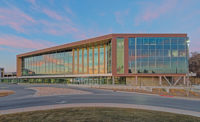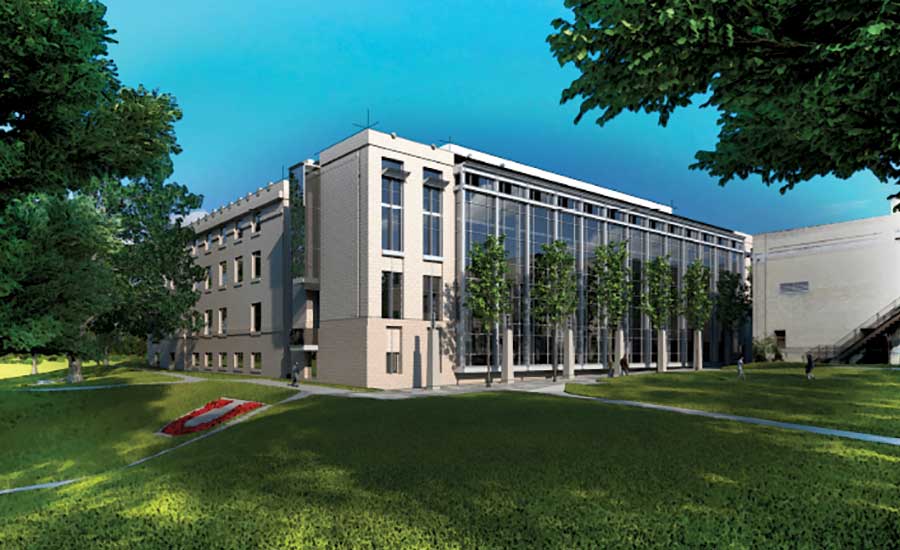State of Utah Selected as Intermountain Area Owner of the Year for 2016

An addition to the Crocker Science Building, now underway on the University of Utah campus, is one of many ways the state is trying to accommodate rising enrollment at its colleges and universities.
RENDERING COURTESY OF OKLAND CONSTRUCTION

UDOT will launch 10 major bridge and road improvement projects this year to manage increased congestion, especially along the heavily populated Wasatch Front. The reconstruction of I-215 is pictured above.
PHOTO COURTESY OF UDOT

Okland Construction is building the eight-story 4th District courthouse in Provo, Utah.
RENDERING COURTESY OF OKLAND CONSTRUCTION



Utah became the fastest-growing state in 2016, when its population, driven by the nation’s highest birth rate and steady in-migration, topped 3 million people, according to the U.S. Census Bureau.
Newcomers are drawn to Utah for its healthy business climate and good jobs.
State leaders are boosting spending for construction and maintenance of state facilities and transportation to manage the growth.
In 2015, state leaders earmarked $550 million to construct a new state prison and recently approved $100 million to build the infrastructure for it. Earlier this year, the state Legislature approved $1 billion in bonds for transportation funding over the next four years. Major projects underway at many state-owned universities and colleges also have been a major driver of construction growth in recent years. For its funding and management of numerous forward-looking projects, ENR Mountain States has selected the state of Utah as its 2016 Intermountain Owner of the Year.
“This year, we have 568 construction projects across the state and oversee a budget of $3.1 billion,” says Jim Russell, newly installed director of the Utah Division of Facilities Construction and Management (DFCM).
The state’s commitment to managing growth has been most evident in the numerous construction projects among its 10 college campuses, especially along the densely populated Wasatch Front. Of DFCM’s top 10 projects from 2016, seven are located on higher-education campuses. Current projects include the $55-million replacement of Orson Spencer Hall at the University of Utah in Salt Lake City, scheduled for completion next August, and the University of Utah’s $44.5-million Crocker Science Building, which will be finished in October.
The Utah Dept. of Transportation, which maintains nearly 3,658 miles of roads in the state, has pushed to keep up with the area’s growth in commuter traffic. UDOT recently completed the $213-million Point project, which widened and improved seven miles of freeway near Draper at the south end of the Salt Lake Valley. UDOT has announced 10 road and bridge projects for this summer valued at around $722 million. Major projects underway include the $71.8-million reconstruction of Interstate 215, 300 East to S.R. 201, and the $61.8-million Mountain View Corridor, from 5400 South to 4100 South in West Valley City, scheduled for completion this fall.
UDOT receives funding from state transportation appropriations, a portion of the state fuel tax, the Federal Highway Administration and the Federal Aviation Administration. The Utah Legislature approved $415 million for new UDOT projects in 2016 and $471 million for 2017.
Conservative Budgets
Russell notes that despite strong growth, state lawmakers have remained conservative in budgeting and approving new projects. Utah is one of only 10 states to maintain a triple-A bond rating with all three major rating agencies, allowing the state to borrow at low interest rates.
“Legislators try not to use bonding much for new projects. They like to maintain about half the bonding capacity in case of a disaster, so there is a level they won’t go below,” Russell says. “If they get some debt paid down, they might use it to fund new facilities, but most buildings, especially in higher education, are funded with some private donations, then one-time funding from the Legislature.”
State Rep. Gage Froerer (R), chairman of the Infrastructure and General Government Appropriations Subcommittee, which oversees the budget for both the DFCM and UDOT, says, “When we look at funding for new projects, like with higher education, we look at a range of issues. We want to be sure there is really a need, and then we look for things like multiple uses, especially at the universities.
“We don’t want a building that will sit vacant for long periods,” he adds, “and if there are spaces that can be used by multiple programs, we look for that. We don’t want duplication. We also want to make sure new buildings are primarily for student needs, so it better have about 70% to 80% classroom space.”
Froerer says that while state leaders prefer to have private funding or an attached revenue stream to a project, they realize that’s not always possible for some institutions.
“At the smaller schools in rural areas that don’t have the ability to bring in large donations, community development becomes part of our analysis. We look at how that project might help a rural community,” he says.
Diversity of Delivery
Russell says the DFCM also looks at a range of different delivery methods when a project is given the green light. “We are using more delivery methods than ever before in the last few years,” he says. “Most of the larger projects we were doing CM/GC, but we are doing more design-build too. We’ve also been doing qualified low bid and more on a value-based system to get the best value and get more of the contractors and subs on board early.”
In recent years, the state has pioneered a qualifying process for subcontractors. “We have them supply a lot of the same information we ask from general contractors as far as a guaranteed maximum price, their labor rates and mark-ups,” Russell says.
“We are lucky to have a fantastic group of designers and contractors here in the state that perform very well. They know us and our processes. It has resulted in good value, and our change orders are very low,” he says.
Richard Thorn, president of the Utah Chapter of the Associated General Contractors agrees that the local AGC members have a good working relationship with state building officials.
“Our members do the majority of the work for the state, and we enjoy a good relationship with the state Legislature and the owners like UDOT and DFCM,” says Thorn.
He adds that Utah has a more collaborative approach to building state projects. “All states have their challenges, but in some places, it seems there is almost an adversarial relationship. We seem to have all the members of the team pulling together on things, and we try to maintain a high standard of ethics and deliver quality work,” Thorn says.
The state has a rating system for all contractors and will issue an evaluation when a project is completed, Russell says. “We issue a rating of one through five, and contractors have to maintain a good rating score to do work with us.”
“For the contractors on the civil side, UDOT is probably one of the best owners to work for,” Thorn says. “We have members who work for DOTs in other states, and I think they will tell you Utah’s is by far the best to work with. Same with DFCM.”






